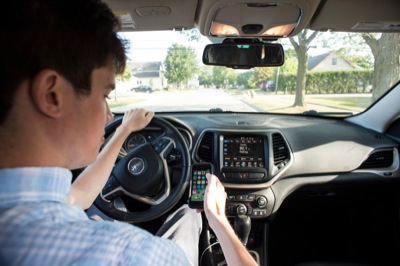Saturday, August 26th, 2017
Driven to distraction
Distracted driving law hard to enforce, officials say
By Tom Stankard

Photo by Mark Pummell/The Daily Standard
Local law enforcement officers notice more drivers are using their phones behind the wheel. Distracted driving is one of the leading causes of accidents across the state.
Local law enforcement officers say more drivers are being distracted by their gadgets - creating dangerous situations on the road.
Auglaize County Sheriff Al Solomon said drivers can be distracted by anything from eating to checking social media on a cellphone.
Celina Police Chief Tom Wale recalled two accidents caused by distracted driving over the past three years. One involved a driver using the phone when the vehicle struck the rear of a school bus on the first day of school. The other occurred when a motorist using the phone ran a red light and struck a vehicle at an intersection.
Across the county line, Solomon stated one accident this summer was possibly caused by distracted driving, though the deputy did not cite the driver.
St. Marys Police Sgt. Shawn Vondrell linked one accident to distracted driving this summer.
Distracted driving was among the leading cause of the 305,964 crashes last year in Ohio, along with speeding, failing to yield and driving under the influence of alcohol or drugs, Ohio Public Safety Department Director John Born said in a news release.
According to OPSD statistics, 12,849 accidents were connected to distracted driving last year. Among those, 2,827 drivers were on the phone, 452 were texting or emailing, 408 were using an electronic communication device for another purpose, 1190 were using another electronic device and 7,172 were distracted by other means in the vehicle.
In Ohio, distracted driving is a secondary offense. As a result, law enforcement officers are not allowed to pull over drivers solely for failing to pay attention.
Districted driving was made a secondary offense with "a good intent," Mercer County Sheriff Jeff Grey said. But he explained the status makes officers' lives "more complicated."
"If it's good enough to be a law, have it be a law that we can enforce," he urged, saying distracted driving should be a primary offense.
Another complication is that minors cannot use their phones behind the wheel, Grey said. However, that provision is almost impossible to enforce because officers can't determine the driver's age without stopping the vehicle.
Properly educating younger drivers not to use their phones while behind the wheel is best way to help prevent such accidents in the future, Grey, Solomon and Wale agreed.
The common belief is that younger drivers are more distracted by using cellphones than older drivers. Officers, however, said this is not necessarily so.
"I know there are people my age who are doing the same thing by using their phones when they're not supposed to be," Solomon said.
Also, motorists have been distracted for other reasons throughout the years, he pointed out.
"People would reach down for their purse, light a cigarette, insert a CD or change the radio station," he said. "Its no different than that."
Newer car models are often equipped with the latest technology, which Grey believes could add more distractions.
"New cars now come with all that stuff on the dashboard. I can push a button and get the whether while I'm driving. So technology is good and bad."
Ohio State University's Risk Institute Director Phil Renaud said his organization is conducting a study focused on how newer technology impacts motorists.


